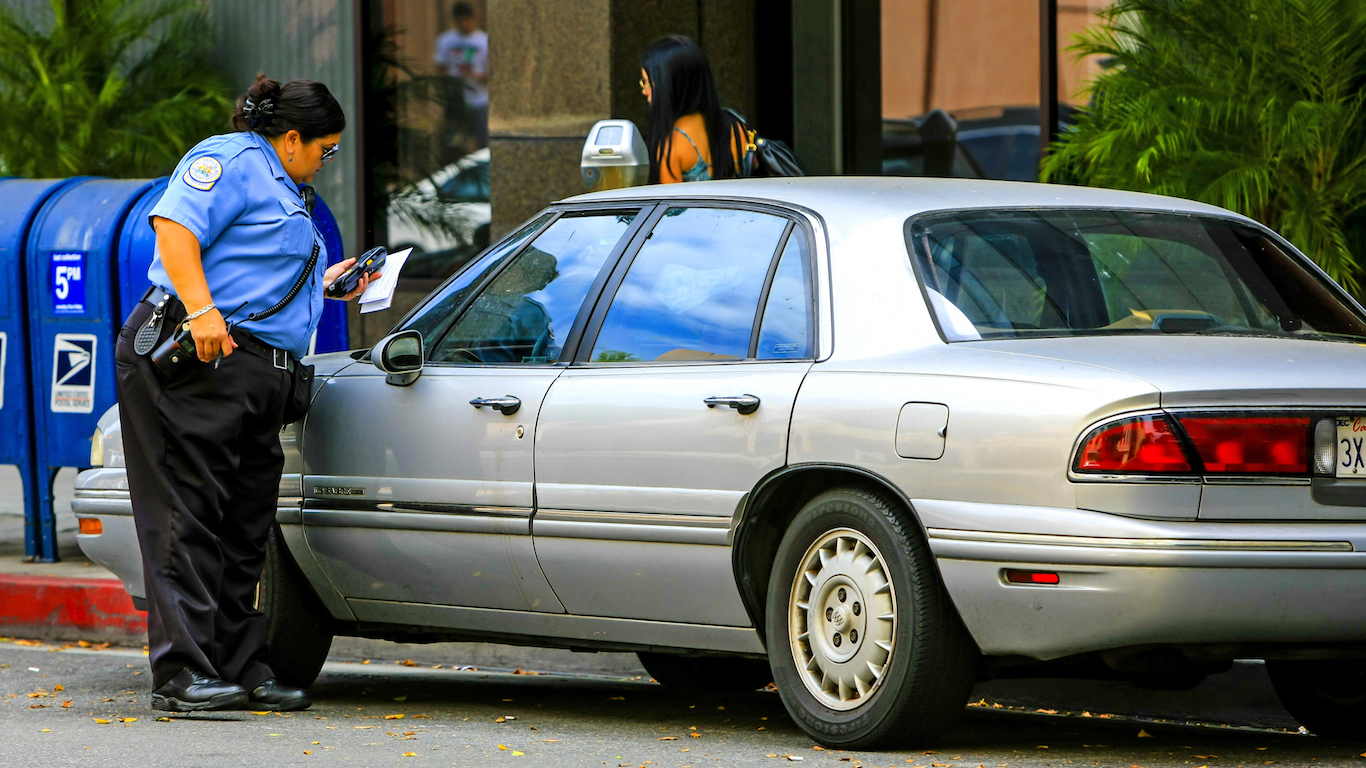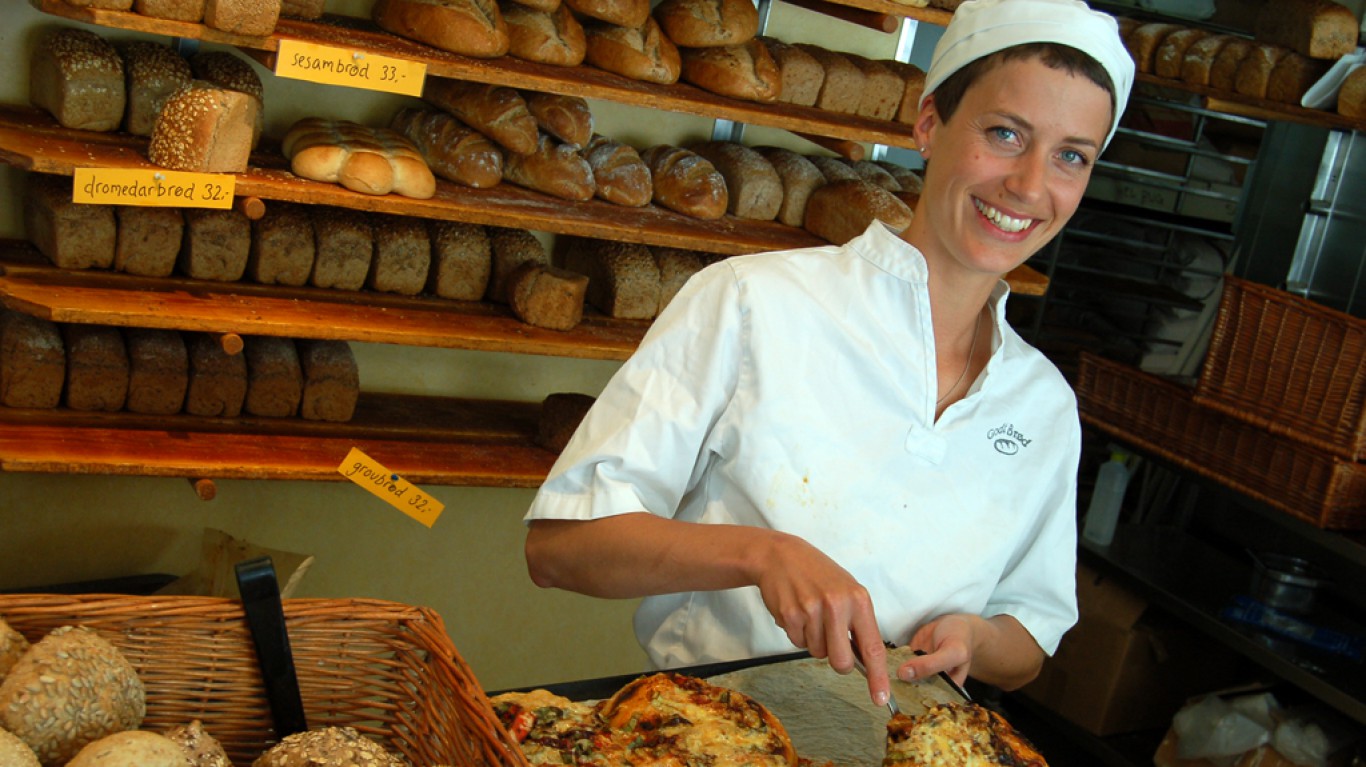Special Report
20 Jobs That Have Become Dominated by Women

Published:
Last Updated:

The landscape of the U.S. job market has changed considerably in recent years. One of the most notable trends is the increasing participation of women in the workforce. In 2000, women held approximately 40.5% of all jobs in the United States. As of 2016, 43.1% of all U.S. workers were female.
The overall uptick in the labor force participation of women obscures the massive changes that have occurred in some professions. In some occupations, the shares of female workers climbed by over 20 percentage points since the turn of the millennium.
Many of the jobs in which female participation is increasing most rapidly are high paying. In half of the jobs on this list, median earnings for women are higher than the median wage for all workers of $45,860. Still, women do not earn more than their male counterparts in any of the jobs on this list.
Men and women each tend to sort into different jobs, which largely explains the gender pay gap in the United States. The rising shares of women in certain high paying jobs therefore helps explain gains made closing the gender pay gap. In 2000, women earned just 73 cents for every dollar men earned. As of 2016, the gender pay gap narrowed to 80 cents on the dollar. With a handful of exceptions, the gender pay gap shrank in the majority of jobs on this list.
24/7 Wall St. compared U.S. Census data from 2000 and 2016 on employment composition by gender in over 300 occupations to identify the 20 jobs that have become dominated by women. More than half of all workers are women in every job on this list, and the increase in the share of women working in these professions range from 6.4 to 25.1 percentage points.
Click here to see the 20 jobs that have become dominated by women.
Click here to see our detailed findings and methodology.

20. Public relations specialists
> 16 yr. change in share of women: 6.4 ppt.
> 2016 female workers: 67,660 (65.3% of total)
> 2000 female workers: 56,410 (58.9% of total)
> Median earnings: $65,386
Public relations was a female-dominated profession already in 2000, and over the last 16 years, it has become even more so. The share of women working as public relations specialists increased by 6.4 percentage points, from 58.9% in 2000 to 65.3% in 2016.
Like several jobs on this list, public relations is a relatively high-paying field. The median annual wage among PR specialists is $65,386, far higher than the median annual wage across all occupations of $45,860. Still, women working in PR typically earn less than their male counterparts. The median annual salary among female workers is just $61,547, about 80% of the median salary among male workers in the profession.
[in-text-ad]

19. Office machine operators, except computer
> 16 yr. change in share of women: 6.5 ppt.
> 2016 female workers: 16,525 (62.9% of total)
> 2000 female workers: 18,540 (56.4% of total)
> Median earnings: $30,788
Office machine operators perform a range of administrative duties, including photocopying. Duties of office machine operators exclude those performed on computers, and partially as a result, the job is becoming less common. Though the share of women working as office machine operators increased by 6.5 percentage points from 2000 to 2016, the number of women working in the occupation declined by about 2,000. No other job on this list reported a such a steep decline. Today, 62.9% of office machine operators are female, compared to 56.4% in 2000.

18. Social and community service managers
> 16 yr. change in share of women: 6.6 ppt.
> 2016 female workers: 205,242 (69.3% of total)
> 2000 female workers: 112,730 (62.7% of total)
> Median earnings: $56,610
Social and community service managers is a rapidly growing field. The number of women working in the occupation climbed by about 9,500 since 2000, the largest total increase of any job on this list. Over the same period, the share of women working in the occupation rose from 62.7% to 69.3%. The job typically involves managing community outreach, social work, and counseling.
The typical female worker in the field earns $52,444 a year, or about 76.7% of the annual compensation for the typical male worker. Across all occupations, women typically earn 80.2% of what men earn.

17. Production, planning, and expediting clerks
> 16 yr. change in share of women: 6.7 ppt.
> 2016 female workers: 162,313 (57.3% of total)
> 2000 female workers: 130,680 (50.6% of total)
> Median earnings: $48,582
Production, planning, and expediting clerks are generally responsible for coordinating the distribution of materials and workflow between departments for a given project and ensuring deadlines are met within budget. Today, women account for 57.3% of workers in the occupation, up from 50.6% in 2000.
While the share of women working as production, planning, and expediting clerks is up by a nearly nation leading 6.7 percentage points since 2000, it is one a minority of occupations with a worsening gender pay gap. Nationwide, the pay gap improved from women earning 72.7% of men’s compensation in 2000 to 80.2% in 2016. In production, planning, and expediting, however, the pay gap worsened from 71.3% to 65.8% over the same period.
[in-text-ad-2]

16. Parking enforcement workers
> 16 yr. change in share of women: 6.8 ppt.
> 2016 female workers: 2,401 (50.8% of total)
> 2000 female workers: 1,420 (44.0% of total)
> Median earnings: $39,298
Parking enforcement workers are responsible for patrolling a designated area, often a parking lot or city street, and ticket illegally parked vehicles. In 2000, the majority of parking enforcement workers (56%) were male.In 2000, the majority of parking enforcement workers — 56% — were male. Since then, about 1,000 more women work in the occupation, and now women comprise a slight of 51% majority of all workers in the field. The share of women working in all occupations rose from 41% to 43% over the same period.
Though the majority of jobs on this list are relatively high paying, parking enforcement is not. The typical worker in the occupation earns $39,298 a year, below the $45,860 average earnings across all occupations.

15. Technical writers
> 16 yr. change in share of women: 6.8 ppt.
> 2016 female workers: 27,568 (58.2% of total)
> 2000 female workers: 26,560 (51.4% of total)
> Median earnings: $71,388
Coinciding with rising college attainment among American women, science, engineering and other technical fields continue to attract growing numbers of female applicants and workers. Technical writers write technical materials such as equipment manuals, appendices, or operating and maintenance instructions. Female employment in most jobs on this list rose to a majority share since 2000. Somewhat of an exception, women already comprised most jobs in the field even in 2000, when the 26,560 women employed in the job made up 51.4% of all such professionals. By 2016, the share of women among technical writers rose to a commanding 58.2% majority.
[in-text-ad]

14. Lodging managers
> 16 yr. change in share of women: 6.9 ppt.
> 2016 female workers: 56,675 (52.7% of total)
> 2000 female workers: 42,820 (45.8% of total)
> Median earnings: $45,875
The number of women working as lodging managers — or hotel, motel, and bed and breakfast managers — increased by nearly 14,000 over the last 16 years. Meanwhile, the number of men working in the profession remained effectively unchanged at 50,893. The increasing ranks of female workers turned the once male-dominated occupation into a female dominated one as the share of women in the occupation rose from 45.8% to 52.7% over the same period.
At $41,285, the median annual wage for women working in as lodging managers is only slightly higher than the $40,675 median wage for women across all occupations.

13. Compliance officers
> 16 yr. change in share of women: 7.5 ppt.
> 2016 female workers: 119,140 (52.6% of total)
> 2000 female workers: 36,500 (45.1% of total)
> Median earnings: $69,262
Compliance officers are responsible for ensuring their organizations are conforming to laws and regulations in their business operations. As recently as 2000, the majority of compliance officers were male. However, over the 16 years since, the number of women working in the occupation more than tripled, and now, about 53% of compliance officers are female. Over the same period, the gender pay gap in the occupation has also improved considerably. Today, the median annual income among female compliance officers is $64,588, or 88% of the median income among their male counterparts. In 2000, women earned 79.4% of what men in the occupation earned. Across all occupations, women earn just 80% of what men earn, up from 73% in 2000.

12. Nonfarm animal caretakers
> 16 yr. change in share of women: 7.7 ppt.
> 2016 female workers: 86,341 (71.4% of total)
> 2000 female workers: 32,130 (63.7% of total)
> Median earnings: $25,210
Nonfarm animal caretakers include those who exercise, groom, and feed animals in a range of different settings, from zoos and aquariums to kennels and animal shelters. Since 2000, the number of women working as animal caretakers has more than doubled, and today, 71.4% of all workers in the occupation are female, a larger share than the majority of jobs on this list.
While female employment has strengthened far faster among nonfarm animal caretakers than in most jobs, the gender pay gap has worsened slightly. Women in the occupation earn just 78.7% of what their male counterparts earn, down from an 82.4% wage gap in 2000. Across all occupations, the gender pay gap improved from 72.7% to 80.2% over the same period.
[in-text-ad-2]

11. Fabric and apparel patternmakers
> 16 yr. change in share of women: 7.9 ppt.
> 2016 female workers: 1,746 (82.6% of total)
> 2000 female workers: 2,780 (74.7% of total)
> Median earnings: $61,630
Few jobs in the United States — and none on this list — are as female dominated as fabric and apparel patternmakers. Currently, 82.6% of workers in the occupation are female, up from 74.7% in 2000. The 7.9 percentage point increase was also the 11th largest such increase in any job.
In a break from the national trend of increasing gender wage equality, women working as fabric and apparel patternmakers now make less than their male counterparts. A decade ago, wages for women in the occupation were higher than that of men. Today, the typical female worker earns $61,097 a year compared to the $66,227 median annual wage men earn.

10. Writers and authors
> 16 yr. change in share of women: 10.2 ppt.
> 2016 female workers: 74,871 (56.6% of total)
> 2000 female workers: 37,850 (46.4% of total)
> Median earnings: $55,464
Male authors have dominated literature and journalism the world over. It is telling that for hundreds of women have chosen to write under male pen names in order to avoid prejudice in a publishing industry dominated by men. In the United States, the traditionally-lopsided distribution has steadily shifted. Women have had higher college completion since 1986, which has likely contributed to the rising share of women writers. In terms of employment, a majority of writers and authors are women.
[in-text-ad]

9. Opticians, dispensing
> 16 yr. change in share of women: 10.3 ppt.
> 2016 female workers: 34,322 (71.0% of total)
> 2000 female workers: 20,570 (60.7% of total)
> /Median earnings: $37,389
Women account for 71% of all opticians, professionals who help fit customers with eyeglasses and frames, a more than 10 percentage point increase from their share in the profession a decade ago.
Though women are much better represented among opticians than they were in 2000, the job has one of the worst gender pay gaps of any in the United States. The median annual wage for women in the profession is just $35,058, or 69.3% of the median salary among men of $50,622. As is the case with several other occupations on this list, the gender pay gap is also worse today than it was 16 years ago, when women in the profession earned 75.3% of what their male counterparts earned.

8. First-line supervisors of personal service workers
> 16 yr. change in share of women: 10.7 ppt.
> 2016 female workers: 48,488 (65.4% of total)
> 2000 female workers: 41,980 (54.7% of total)
> Median earnings: $32,240
Americans working as supervisors of personal service workers in a range of professions, including flight attendants, hairdressers, and caddies, are far more likely to be female than male. Over the last 16 years, the share of women in the profession jumped from 54.7% to 65.4%, one of the largest increases of any job for which more than half of all workers are women. The uptick was attributable both to a declining number of men in the field and an increase in the number of women. Between 2000 and 2016, the number of men working as supervisors of personal service workers declined from 34,780 to 25,605. Over the same period, the number of women climbed from 41,980 to 48,888.

7. Bakers
> 16 yr. change in share of women: 11.0 ppt.
> 2016 female workers: 80,114 (54.0% of total)
> 2000 female workers: 39,210 (43.0% of total)
> Median earnings: $25,848
Cooking and baking have long been associated with female labor, such as the mother feeding her family or in memories of Grandma’s secret pie recipe. Outside the home, however, professional baking has traditionally been men’s work — and this was the case until not too long ago. Since 2000, though, the number of female bakers more than doubled, resulting in a majority share of women bakers. The jobs with the fastest rising shares of female workers contain a mixture of high and low median earnings. With median earnings of only $25,848 a year, bakers are paid the least of any job on this list. And as is generally the case in low-income professions, the gender pay gap is all but nonexistent in the baking occupation.
[in-text-ad-2]

6. Animal trainers
> 16 yr. change in share of women: 11.2 ppt.
> 2016 female workers: 15,037 (51.8% of total)
> 2000 female workers: 9,180 (40.6% of total)
> Median earnings: $29,978
As recently as 2000, the majority of animal trainers were male. Since then, the number of women in the occupation increased by about 6,000, while the number of men working as animal trainers increased by only about 600. As a result, 51.8% of all animal trainers in the United States are now female, up from 40.6% in 2000.
As is the case with many jobs on this list, as female representation among animal trainers increased, so has income inequality. Women earn just 77.9% of what their male counterparts in the profession do, down from 81.1% 16 years ago.

5. Graders and sorters, agricultural products
> 16 yr. change in share of women: 12.0 ppt.
> 2016 female workers: 21,342 (65.0% of total)
> 2000 female workers: 6,240 (53.0% of total)
> Median earnings: $21,235
The number of graders and sorters of agricultural products in the United States nearly tripled between 2000 and 2017. Women accounted for the overwhelming majority of the increase, climbing from 6,240 workers in 2000 to 21,342 in 2016.
Most jobs on this list are higher paying than average, but graders and sorters of agricultural products is not one of them. The median income among all workers in the occupation is just $21,235, less than half the median annual wage across all occupations. While wages are low for graders and sorters of agricultural products, they are relatively equal along gender lines. The median income for females in the occupation is 90.6% of the median income among males. Across all occupations, women earn just 80.2% of what men in the same jobs earn.
[in-text-ad]

4. Public relations and fundraising managers
> 16 yr. change in share of women: 12.6 ppt.
> 2016 female workers: 34,416 (67.3% of total)
> 2000 female workers: 29,480 (54.7% of total)
> Median earnings: $77,835
In 2000, about 55% of all public relations and fundraising managers were women. Today, over two-thirds are. Over the last 17 years, the number of women working in the field increased by about 5,000, while the number of men dropped by about 8,000.
PR and fundraising managers is one of the highest paying jobs on this list with one of the smallest gender pay gaps. The median income among workers in the profession is $77,835 a year, well above the $45,860 median income across all occupations. Additionally, women earn about 90% of what the typical male in the occupation earns, considerably better from the 80% gender pay gap across all jobs nationwide.

3. Pharmacists
> 16 yr. change in share of women: 15.5 ppt.
> 2016 female workers: 117,126 (54.6% of total)
> 2000 female workers: 57,610 (39.1% of total)
> Median earnings: $120,878
Since 2000, the number of women working as pharmacists roughly doubled from 57,610 to 117,126. Less than two decades ago, fewer than 40% of pharmacists were women. As of 2016, over half of all pharmacists in the United States were female.
The typical pharmacist earns about $121,000 annually, more than double the $46,000 median annual wage across all occupations. Not only are pharmacists highly compensated, but also the occupation’s gender wage gap is nearly non-existent. Female pharmacists earn about 97% of what their male counterparts take home, up from 89% in 2000, and far more than the 80% gender wage gap across all occupations.

2. Natural sciences managers
> 16 yr. change in share of women: 22.5 ppt.
> 2016 female workers: 9,452 (52.8% of total)
> 2000 female workers: 4,990 (30.3% of total)
> Median earnings: $92,161
The natural science management occupation is one that involves planning and directing the work of scientists in any number of fields, including life science, physical science, math, and statistics. Within the last two decades, fewer than one in three natural science managers were female. Today, over half are. The change was due to both a declining number of men in the field and an increasing number of women. Between 2000 and 2017, the number of men working as natural science managers fell from 11,500 to 8,464. Meanwhile, the number of women in the occupation nearly doubled from 4,990 to 9,452 over the same period.
[in-text-ad-2]

1. Veterinarians
> 16 yr. change in share of women: 25.1 ppt.
> 2016 female workers: 38,885 (59.1% of total)
> 2000 female workers: 15,140 (34.0% of total)
> Median earnings: $90,063
No job has become dominated by women faster than veterinarians. The number of women employed as veterinarians has more than doubled since 2000, resulting in a 25 percentage point increase in the share of female vets. Not all jobs on this list pay well. But with educational requirements as or more rigorous as physicians for humans, the median earnings for veterinarians of $90,063 is one of the highest in the nation. The rising share of female animal doctors mirrors the longstanding trend of women entering science and engineering occupations at higher rates.
Detailed Findings & Methodology
In the majority of jobs on this list, the number of women working in the occupation increased at a faster rate than the number of men. In seven jobs on this list, the number of men actually declined since 2000 as the number of women increased.
Some occupations dominated by women have fewer women working today than in 2000. Two occupations that have become dominated by women actually have fewer women working today than in 2000. Today, there are 2,015 fewer office machine operators and 1,034 fewer fabric and apparel patternmakers than there were in 2000. Either the number of men working in these jobs fell at a far faster rate than the number of women, or the number of men in the occupation has historically been relatively small.
The majority of jobs now dominated by women are relatively high paying. Across all occupations, the typical American worker earns $45,860 a year. In 10 of the jobs that have become dominated by women, the median income is higher than the national median.
However, increasing female representation in the workplace does not always translate to more equitable pay. Overall, the pay gap has narrowed considerably in the last 16 years. Since 2000, the median annual wage among men in the United States increased by 34.1%. Meanwhile, the median wage among women increased by 47.9%.
Still, just eight of the 20 jobs on this list reported a greater than average increase in women’s pay. In seven jobs on this list, the pay gap has widened since 2000. While there are occupations on this list — like pharmacists and technical writers — for which the pay gap is now nearly non-existent, in the majority of jobs on this list, the pay gap is worse than the average across all occupations of 80 cents on the dollar.
Despite being increasingly represented in these jobs, women do not earn more than their male counterparts in any of the jobs on this list.
To identify the 20 jobs that have become dominated by women, 24/7 Wall St. reviewed Census data from 2000 and 2016 on employment composition by gender in over 300 occupations. Data from 2016 comes from the U.S. Census Bureau’s American Community Survey while 2000 data from decennial census. Job codes from 2016 were matched to their equivalent from 2010. In order to be considered, an occupation needed to be at least 50% female in 2016. Only the 20 jobs with the largest percentage point increase in female employment composition were ranked.
Want retirement to come a few years earlier than you’d planned? Or are you ready to retire now, but want an extra set of eyes on your finances?
Now you can speak with up to 3 financial experts in your area for FREE. By simply clicking here you can begin to match with financial professionals who can help you build your plan to retire early. And the best part? The first conversation with them is free.
Click here to match with up to 3 financial pros who would be excited to help you make financial decisions.
Have questions about retirement or personal finance? Email us at [email protected]!
By emailing your questions to 24/7 Wall St., you agree to have them published anonymously on a673b.bigscoots-temp.com.
By submitting your story, you understand and agree that we may use your story, or versions of it, in all media and platforms, including via third parties.
Thank you for reading! Have some feedback for us?
Contact the 24/7 Wall St. editorial team.